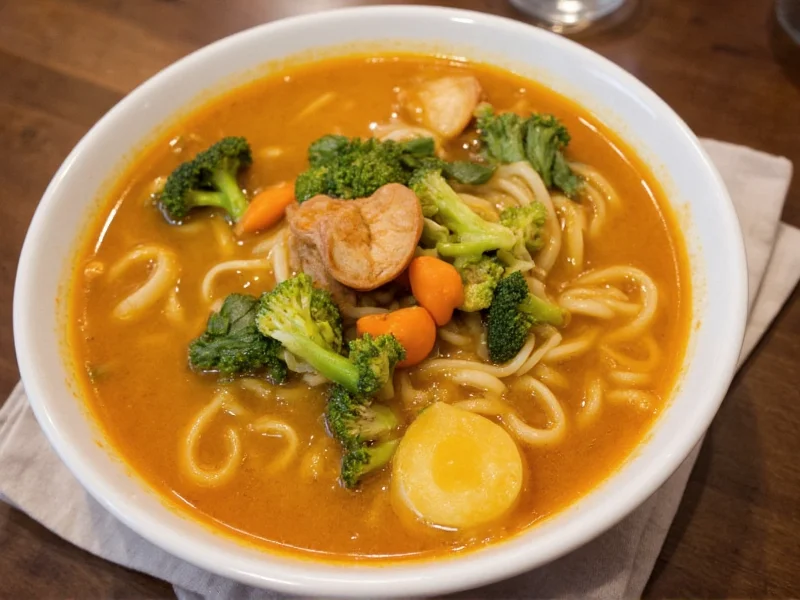Creating exceptional veggie noodle soup requires understanding ingredient synergy and proper technique. Unlike basic canned versions, homemade vegetable noodle soup delivers superior flavor complexity and nutritional value. This guide reveals professional methods for building depth of flavor while maintaining the soup's light, refreshing character.
The Nutritional Powerhouse in Your Bowl
Vegetable noodle soup serves as a complete nutritional package when properly formulated. The combination of colorful vegetables provides diverse phytonutrients, while broth contributes minerals and hydration. Noodles add complex carbohydrates for sustained energy. This balance makes veggie noodle soup an ideal meal for recovery, weight management, or everyday nourishment.
Nutritional Comparison: Homemade vs. Canned
Understanding the nutritional differences between homemade and canned vegetable noodle soup helps make informed dietary choices. Data from the University of Nebraska-Lincoln Extension (2020) provides a clear comparison of key nutrients per 1-cup serving:
| Nutrient | Homemade (1 cup) | Canned (1 cup) |
|---|---|---|
| Calories | 100 | 100-150 |
| Sodium | <200 mg | 400-800 mg |
| Dietary Fiber | 3 g | 2-3 g |
| Vitamin A | 40% DV | 15% DV |
| Vitamin C | 30% DV | 10% DV |
Source: University of Nebraska-Lincoln Extension, "Homemade Soup: A Nutritious and Economical Choice"
Essential Components of Perfect Veggie Noodle Soup
Three elements determine your soup's success: broth quality, vegetable selection, and noodle preparation. Professional chefs emphasize building layers of flavor rather than relying on single ingredients.
| Component | Professional Recommendation | Common Mistake |
|---|---|---|
| Broth Base | Homemade vegetable stock with roasted mirepoix | Over-reliance on store-bought broth |
| Vegetable Timing | Add delicate veggies last to preserve texture | Boiling all vegetables together |
| Noodle Selection | Cook noodles separately to prevent mushiness | Boiling noodles directly in soup |
Step-by-Step Preparation Guide
Follow this professional method for restaurant-quality results:
- Build flavor foundation: Sauté onions, carrots, and celery in olive oil until caramelized (8-10 minutes)
- Enhance depth: Add tomato paste and cook 2 minutes until brick red
- Create broth: Pour 6 cups homemade vegetable stock, scraping browned bits from pot bottom
- Add hard vegetables: Include potatoes, parsnips, and mushrooms; simmer 15 minutes
- Incorporate delicate ingredients: Add zucchini, spinach, and cooked noodles during final 5 minutes
- Finish with brightness: Stir in lemon juice and fresh herbs just before serving
Dietary Adaptations Without Sacrificing Flavor
Professional kitchens accommodate various dietary needs while maintaining exceptional taste:
- Gluten-free vegetable noodle soup: Use rice noodles or spiralized zucchini, adding them during the final cooking stage
- Vegan vegetable noodle soup variations: Boost umami with dried mushrooms and nutritional yeast instead of dairy
- Low-sodium preparation: Roast vegetables first, use fresh herbs, and finish with citrus for flavor without excess salt
- Protein-enhanced versions: Add white beans or tofu cubes during the final simmering stage
Contextual Considerations for Optimal Use
While vegetable noodle soup offers versatility, recognizing its contextual boundaries ensures it meets specific dietary goals:
- Ideal for light meals and recovery: The National Center for Complementary and Integrative Health states that clear vegetable broths help maintain hydration and provide electrolytes during illness recovery, making this soup an excellent choice for convalescence (NCCIH, 2022).
- Not sufficient for high-protein requirements: The Academy of Nutrition and Dietetics recommends 20-30 grams of protein per meal for muscle maintenance. A standard serving of vegetable noodle soup provides only 3-4g protein, so adding 1/2 cup white beans boosts protein by 7g without compromising flavor (EatRight, 2023).
- FODMAP sensitivity considerations: Monash University's Low FODMAP Diet guidelines indicate that onions and garlic (common in mirepoix) are high in FODMAPs. They suggest using green onion tops and omitting garlic for low-FODMAP versions during the elimination phase (Monash FODMAP, 2023).
- Sodium management: The American Heart Association advises limiting sodium to 1,500mg daily for optimal heart health. Homemade vegetable noodle soup can be prepared with under 200mg sodium per serving, making it suitable for sodium-restricted diets (AHA, 2023).
Advanced Techniques for Flavor Development
Master chefs employ these methods to elevate basic vegetable noodle soup:
Creating a mirepoix (equal parts onions, carrots, celery) forms the flavor base. For deeper complexity, roast these vegetables before sautéing. The Maillard reaction during roasting develops hundreds of flavor compounds that boiling cannot achieve. Adding a Parmesan rind during simmering (remove before serving) provides savory depth without making the soup non-vegetarian.
Acidity balance proves crucial in vegetable noodle soup. Many home cooks under-season with acid, resulting in flat-tasting broth. Professional kitchens add acid in three stages: a splash of white wine when sautéing vegetables, a squeeze of lemon with the broth, and final adjustment with vinegar or citrus just before serving.
Storage and Reheating Best Practices
Proper storage maintains texture and flavor for future enjoyment:
- Store components separately: Keep noodles, broth, and vegetables in separate containers
- Cool rapidly: Divide large batches into shallow containers for quick cooling
- Reheat gently: Warm broth first, then add vegetables and noodles separately
- Refresh flavors: Add fresh herbs and a splash of acid when reheating
Vegetable noodle soup maintains best quality for 3-4 days refrigerated. For longer storage, freeze broth and vegetables separately from noodles, which become mushy when frozen.
Common Preparation Mistakes to Avoid
Even experienced cooks make these errors when preparing healthy vegetable noodle soup:
- Overcooking vegetables: Different vegetables require different cooking times. Add delicate greens during the final minutes
- Using water instead of proper broth: Water lacks the flavor foundation needed for satisfying soup
- Adding noodles too early: Noodles continue cooking in hot broth, becoming unpleasantly soft
- Under-seasoning: Soup needs more seasoning than other dishes due to its liquid nature











 浙公网安备
33010002000092号
浙公网安备
33010002000092号 浙B2-20120091-4
浙B2-20120091-4